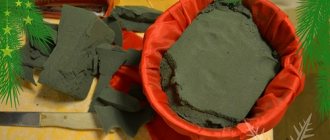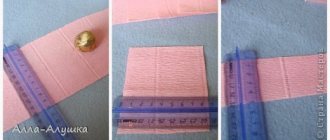Needlework
07/11/2018 Anastasia Prozheva
Sitting comfortably in a comfortable hammock and relaxing in the shade of trees in your summer cottage is a dream for everyone! In order to turn a dream into reality, it is not at all necessary to spend money on a purchase. A hammock is an indispensable place to relax, which is easy to make with your own hands. In this article you will find: weaving a hammock with your own hands, a diagram of the product, its application, history of origin and instructions for making a hammock using the macrame technique.
The macrame weaving style is one of the oldest and most popular types of needlework. What is this process? We can say that this is a technique of weaving various products, which consists of tying knots. Such products were popular not only among poor people, but were popular even on rich estates. Previously, only sailors used a hammock, as it was difficult to rest while sailing. There are many variations of macrame weaving. Weaving a hammock for beginners is easy to do with the diagram and text instructions described below.
Nowadays, diagrams of the macrame knot technique can be made on a laptop and tablet. The method of making things with your own hands is losing its relevance today. But do not forget about the uniqueness and durability of things that you can do yourself at home. Hanging chairs are also made using the hammock principle. The main difference between a chair and a hammock is the size and method of hanging. The hammock is fixed on two supports, and one is enough for the chair.
After studying the master class and learning what to do step by step, you can make incredibly cool crafts. Often, factory-made items are much inferior in quality to products made independently. This requires a minimum of knowledge and a small investment of time, but you can relax while making a beautiful thing. It will fit perfectly into the interior, as it was made specifically for it.
Related article: DIY pumpkin carriage: step-by-step instructions with photos
Ropes for a hammock: from A to Z
You can weave a macrame hammock from a variety of materials: linen, cotton, hemp and sisal ropes are suitable. Home craftsmen often use linen or curtain cord.
- Strongly twisted threads are well suited for work: their knots are clear, embossed, and the product does not deform. Weakly twisted fleecy threads become shaggy, the connected knots have an inexpressive texture - the pile “blurs out” it.
- To get a beautiful pattern with an expressive texture, choose a cord with a round cross-section.
- Weaving something from a stiff, coarse rope is quite difficult, and the work may not be the most pleasant. Make sure you have thin knitted gloves; tying knots is much easier in them.
- Do not use threads with a slippery surface (containing synthetics), knots made of this material become untied, requiring more effort.
If uneven, coarse threads are used, the hand-woven bed may not look as good as in the picture. If it irritates your aesthetic senses, pet it and the thread defects will become less noticeable. This is done like this: the product is laid with the wrong side up on a soft mat, covered with 2-3 layers of wet gauze and applied with a hot iron so as not to deform the knots. After the gauze has dried, the mesh should be allowed to dry.
A wicker hammock can be washed with care, but should not be twisted. After washing, it should be wrapped in fabric to remove excess moisture, then dried a little, straightened, and then ironed with a hot iron through damp gauze.
Calculation of material consumption
It is difficult to accurately calculate the required thread length. Its consumption depends on the size of the product, the use of certain knots and patterns, the texture and thickness of the threads, and the individual style of the craftsman (everyone has their own degree of tightening of the knots). Ready-made hammocks, woven according to the same pattern by different people, have different lengths and widths. Therefore, the calculation of the product should be carried out with a margin. The thread attached to the base should be 4 times longer than the dimensions of the finished product.
When tying the thread to the base, it folds in half. The length of the thread, accordingly, should double and become 8 times longer than the planned product. If the mesh is created from individual elements, then the length of the threads is calculated separately.
The consumption of the rope also depends on the size of the cells. The larger they are, the fewer threads will be needed, but any mesh will deform over time. The lower quality the material, the more it will stretch, so keep this consideration in mind.
Most often, hanging nets are woven using a bowline (triangular) knot because of its reliability. If a nylon thread is used, its thickness must be at least 6 mm; a thinner thread will not withstand the strength test of intensive use. If you are too strong, the product will resemble a volleyball net. Yes, a 10 mm thick rope will be guaranteed to be strong, but the appearance of such a hammock will be unsightly.
Calculation option: planned hanging mesh 180x70 cm with diamond-shaped cells 40x80 mm (cell diameter 65 mm). Weaving will be done with a bowline knot. You will need 40 ropes 5 m long, the total consumption is 200 m.
Do not rush to weave a hanging bed immediately after reading this material and performing the calculations, no matter what “golden” hands you have. We recommend performing a test weave of at least 8 ropes. This approach will certainly reveal several unaccounted details and allow you to better prepare for the real work.
Take 8 pieces of simple rope, 2 meters long, something for a wooden base, and try to make different knots with different cell sizes. Having decided on the chosen knot and the diameter of the cells, weave the mesh along the entire length of the ropes. Then measure the dimensions of the test product and recalculate the material consumption for the planned structure.
When you purchase the rope from which you are going to weave a net, test the consumption of materials a second time. Take 2 pieces of 10 meters long, wrap them around a round wooden rod, getting 4 five-meter threads. Weave them, leaving 25 cm at the ends for fastening, measure the resulting product and adjust the calculations. There is nothing to be done; in piece production, accuracy is achieved only experimentally.
Typesetting row
Usually, along the edges, the mesh threads are attached to wooden rods, but they can also be brought into a corner to be grabbed by a metal ring (this will be discussed below). The ends of the ropes from which work begins are called a set row. In practice, more than one method of attaching threads is used; let’s look at the 4 most common ones.
Method 1: Horizontal hinge jumper on the front side
- The thread is folded in half and placed on a wooden handle with the loop facing up.
- The loop bends back and goes under the rod.
- Both ends are threaded into the resulting loop and tightened.
Method 2: crossbar on the wrong side
- The rope is folded in half and placed under the wooden base with the loop facing up.
- The thread folded into a ring is bent forward and wound over the rod.
- Both ends are inserted into the created loop and tightened.
Method 3: Double Hitch (Extended or Extended Hitch)
The crossbars remained on the wrong side. The typesetting row made in this way is denser; the wooden handle does not show through it.
- The thread folded in half is secured using method No. 2.
- Each end (separately) performs one turn.
- The thread that goes around the base is pulled over the loop formed at the bottom.
The attachment to the handle will be even tighter if you make more turns at each end. The same typesetting row can be made so that the bends of the nodes are on the front side, but such a solution looks less neat.
Method 4: Attaching only one end of the thread to the rod
- The upper end of the thread placed under the cutting is fixed at a distance of 2–3 cm from it.
- The lower end of the thread is draped over the base to the right of the upper, then, going around it, it makes a turn; the thread is pulled down.
- The next turn is performed to the left of the upper end, the operation is repeated in a mirror manner. After tightening it, the knot is ready.
When using threads of different colors or different lengths, several fastening methods can be used. For example, first hang one rope using method No. 3, not forgetting to leave a gap in the middle of the fastening. Then a second thread is tied to the left space using method No. 2.
Let's get started
First, we cut 20 meters of rope for fasteners. We cut the rest into 6 meters into equal parts. Then we fasten each rope with a loop and a knot on the bar. Next we weave a hammock. The most suitable cell size, so as not to get confused and not fall through in the hammock while relaxing, is seven centimeters. Once you have finished the hammock, attach the ends of the cords with knots to the second plank and to both straps with fasteners.
Hammock Weaving Guide:
- Initially, you need to plan the size of the hammock. For example, its dimensions are 2.5 × 1 m. To do this, you need to knit a mesh, casting from 20 to 30 loops across the width. Remember, the thicker the rope, the fewer loops you need to cast.
- The process of knitting a hammock is reminiscent of making fabric. Knit the first row, turn the product wrong side out and knit the next one. Then turn over again and knit the third row, and continue in this way until the end.
- It is important to correctly calculate the remainder so that the knot is at the edge of the row and not in the middle. Knots can ruin the appearance of the hammock and cause inconvenience during use.
- When the mesh is ready, prepare the wooden planks. Make holes in the bars for fastening.
- Then, in order, you need to thread the loops from each row into the holes.
- Do this with all the holes and loops, attaching the second bar to the future hammock.
- Gather the free ends of the rope together, fold them into a ring shape, wrap them across and tighten. We repeat the same with the other side of the product.
- Thread the holder into the newly formed holes or a tight cord that will secure the hammock to the trees.
Article on the topic: Snood for girls with knitting needles with diagrams and descriptions
The relaxation hammock is ready! A two-hour sleep in this bed completely restores a person after a hard week of work. In a suspended state, it is easier to relax and not take unpleasant little things to heart.
Here are a few photos showing hammock weaving patterns:
You can also watch the video collection for inspiration.
Cornering
Factory products are distinguished by bringing the threads into a ring at the ends. It looks quite attractive, but many craftsmen, planning to weave a macrame hammock with their own hands, abandon this idea. Why? The fact is that the corner (the so-called design solution used) is difficult to weave.
Another consideration influencing the rejection of this idea is the increased density of the resulting angle. It is impossible to fold such a product compactly, please note. But for those who still want to effectively bring all the threads into a ring, a detailed procedure is proposed below.
To weave a corner, you need to have 20 ends of ropes (10 threads), which will ultimately be attached to the body of the mesh. The length of the threads is the same; taken out from the corner, they form a straight line. The estimated 10 threads, folded in half, will look like 20 threads of 150 cm each. After weaving, you will get approximately 40 cm from the crossbar to the top point of the triangle.
Any action performed for the first time is an experiment. Therefore, take the threads a little longer, because cutting is easier than sharpening.
Beautiful DIY hammock: macrame (video)
This hammock chair can be hung not only in the garden, but also in your own apartment. The main thing is that its style is combined with the style of the interior. Even a beginner can handle this weaving. Try it and you will be amazed at the results of your efforts.
How sometimes we want to find that shadow that will give us the freshness of the morning or the luxury of the evening for a long time. And we won’t find anywhere better than under a tree! No matter how the sun tries to reach us, we are surrounded by branches, in which it is easy to hide from the summer heat. This is where the hammock comes to mind! An irreplaceable thing! But store-bought ones are either too expensive, too unreliable, and sometimes just inconvenient.
So a bright thought was born in my head! Why not make a hammock yourself. When I began to research the question of whether this was real, out of habit I began to collect a collection that would include all the subtleties and secrets of working with a hammock. And, of course, I immediately decided to share this collection with you!
Weaving patterns
You can make a macrame hammock with your own hands in exactly the same way as those sold in trade, i.e. simply throw the threads. Weaving will go very quickly, because you won’t need to tie knots. Lying in it for the first time will be comfortable, nothing is pressed into the body. However, the cells will turn out to be unstable, easily changing their size, with the prospect of the formation of holes.
Weaving flat knots (degenerate square knots) will not require much effort either. The rope consumption will not be much more, the size of the cells is easy to adjust. However, such a mesh cannot be overloaded; children should not frolic in it: there is a high probability of the knot turning out under heavy load.
The exact opposite of the thrown threads would be a square knot (double flat knot). The nodes will be a sight to behold, firmly fixed, flat, with the ability to change the size of the cells if necessary. However, the thing will turn out to be quite heavy (this is the most material-intensive method), such a hammock is clearly not intended for hiking.
Another knot that is traditionally used to knit networks deserves attention. This is a bowline (triangular knot). The cells do not tend to change sizes, the rope consumption is average, the weight of the product allows you to take it with you on the road. However, weaving such a knot is a labor-intensive task, and it is difficult to adjust the size of the cells if necessary. In addition, on one side the knots are sharp.
Strengthening the sidewalls
After tying the hanging mesh, do not forget to strengthen its longitudinal edges. Without this measure, the hammock will not be able to withstand the maximum load when getting in and out of it. The binding is made from the same material that was used for the “body” of the mesh, or from a denser one. To weave 1 meter of sidewall it will take approximately 5.5 m of rope.
If cornering is used in the design of the hammock, then the number of threads must be taken as a multiple of 4 (2 threads are attached to 1 thread of the corner). The angle, in turn, is formed by an even number of ropes. In addition, we must not forget that the side ropes also require reliable fixation. In practice, there are 2 options for solving this issue; the schematic drawing below clarifies this in detail.
In the left figure, the side threads are fixed separately on the crossbar; the number of threads used for the hanging net is a multiple of 4 (for example, 40). The mesh shown in the figure on the right is woven from 38 threads, the sidewalls are combined with the outer threads.
How to hang
If there are trees at least 20 cm in diameter on the site, then you can hang a hammock from them. You can also attach one end to a tree and the other to a support.
The support should be made strong and deepened by at least a meter. If this is not possible, then you can buy a special support in the store, but it is not cheap. To install the supports yourself you will need:
- 2 beams for the base, 2.5 m long.
- 2 beams for posts 1.8 m long.
- 2 beams for cross support, 1.2 m long.
The posts are secured with self-tapping screws or bolts to the base. To add rigidity to the structure, special supports are attached to the end of the bases.
Securing the hammock in place
Typically, hanging beds in nature are attached to trees. If they are not nearby or the trunks are thin (diameter less than 15 cm), pillars are dug to a depth of at least 1 m. When selecting a place to mount the product, adhere to the following rule: add 0.3 m to the total length of the mesh and get the required distance between the trees. For example, if the hammock is 2.7 m long, then it is desirable to have 3 m between the trees (supports).
If the distance is smaller, the mesh is suspended higher. In addition, take into account its likely stretching during operation. If the stock is suspended from posts, it is convenient to use threaded hooks for fixation. Keep in mind the following consideration: the larger the hook, the more securely the product will be secured. The hook should be screwed in towards the direction of the slings; this approach will reduce the load on the metal.
You can hang a wicker bed in a city apartment, if you have:
- hammer drill;
- 2 anchor bolts 10x60 mm;
- concrete drills with a diameter of 5 mm;
- concrete drills with a diameter of 10 mm;
- ropes for fastening (if necessary);
- pliers, hammer, pencil.
The work order is as follows:
- Selecting a location, marking. A room width of at least 3 m is desirable; if the size increases to more than 4 m, additional ropes will be required for reliable fixation.
- Making holes, first with a drill of a smaller diameter, then with a larger one.
- Removing concrete chips from the resulting excavation.
- Installing an anchor bolt. If necessary, use a hammer.
- Tighten the nut clockwise (while holding the hook with pliers). You need to make every effort.
- Hanging a rope on a hook, tying a knot.
- Hooking a hammock hook onto a knot in a rope.
- Perform fastening operations for the other party.
Necessary materials
To work you will need the following tools:
- Strong clothesline (approximately 1 cm thick);
- Ruler;
- Scissors;
- Durable wooden planks (2 pcs.).
To make the hammock not only beautiful, but also durable and reliable, you need to use good wear-resistant material. A thick clothesline or cord is suitable for this.
Unlike rope, cord has a low level of comfort. It will be much more comfortable to sit on a soft rope than on an uncomfortable and hard cord.
Let's look at step-by-step instructions for making a hammock.










